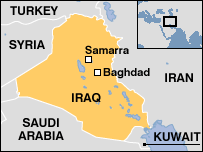
Map of Iraq showing Samarra.
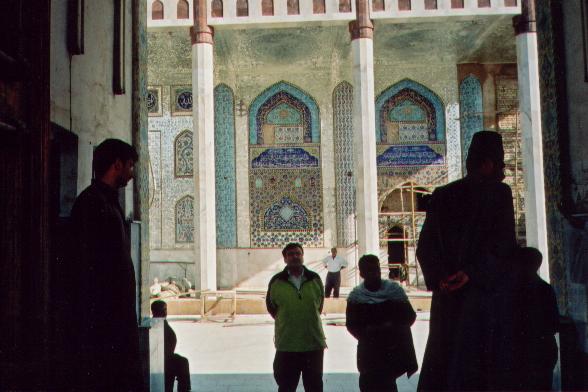
Mosque at Samarra. Photo by author.

Paul with 170 foot high spiral minaret in background.
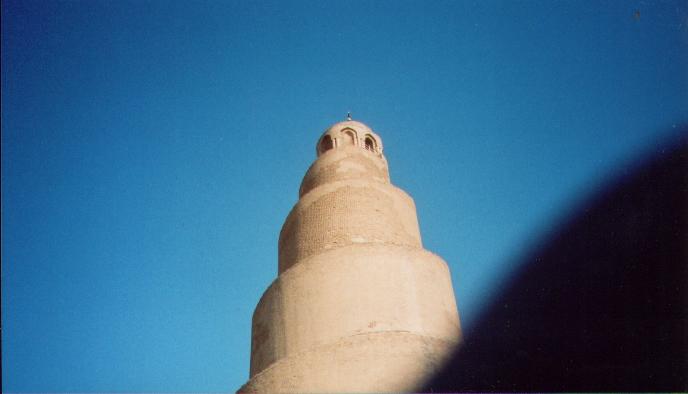
Lana, a young Palestinian on the delegation, climbs to the top. Dizzy!
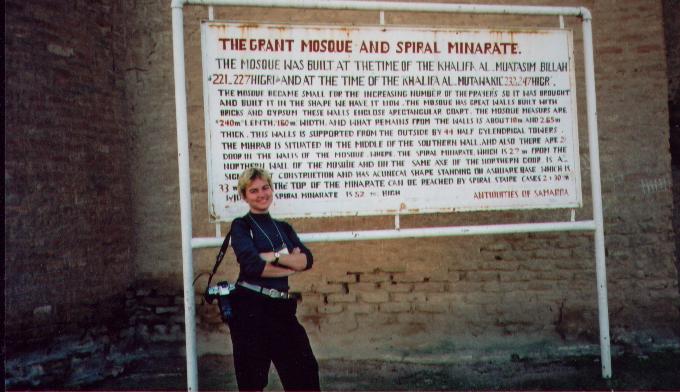
Renee from the IAC delegation at the `Grant` (Grand) Mosque.
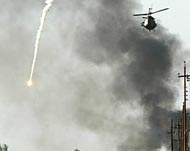
US warplane drops ordnance on Samarra. Photo Al Jazeera.
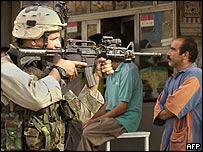
US soldier in Samarra. Photo AFP.

Hospital in Samarra. Photo Al Jazeera.
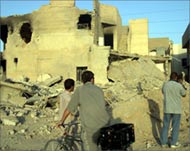
Samarra 2004. Iraqis look at a destroyed house. Photo Al Jazeera.
Oops! Seems Bush and co got it slightly wrong about Iraq’s supposed WMD and also according to Donald Rumsfeld there were no proven links between Saddam and Al Qaeda. Does this mean an apology and a withdrawal from Iraq? Er, probably not. An apology and very generous compensation is the very least the long suffering people of Iraq deserve after being blitzed by 88,500 tons of bombs in the First Gulf War, being subjected to 12 and a half years of brutal sanctions from 1990 to 2003 and then being microwaved by 30,000 bombs and missiles and 1,000-2,000 tons of depleted uranium in the latest war. `A liberal intervention` is how pro-war Guardian columnist David Aaronovitch` described the latest invasion and bombing of Iraq. 37,000 dead Iraqis and over 1,000 dead coalition troops might see it differently.
I myself went to Iraq in January 2001 on a sanctions busting trip with the International Action Center (IAC) when a delegation of about 50 led by former US attorney general Ramsey Clark delivered $100,000 of medicine to local hospitals. We saw some of the country including the beautiful city of Samarra in Central Iraq. This city of some 200,000 inhabitants on the East bank of the River Tigris was for 56 years the capital of the Muslim world.
At the most, the royal palaces and gardens stretched out for a distance of 30 km along the Tigris River. The most prominent remains of this past is the famous Great Friday Mosque from 852 with the unique spiral minaret some 56metres (170.6 feet) high. US bombing raids have recently devastated this beautiful and historical city and I attach some photos of the city then and now.
San Diego activist, writer and truck driver Michael Wolff who was on the 2001 IAC delegation describes his view of the recent fighting:
If the past is any indication, the recent incursion into Samarra killed scores of women and children and maybe a handful of resistance fighters. The U.S. always claims fantastic numbers of enemy killed, no innocent people are ever reported killed by the U.S. and then reality comes when the hospital director comes out and says the hospital wards are filled with innocent people who have been killed and maimed when the U.S. dropped tons of bombs on a village--same old story. The assault on Samarra was telegraphed at least a few days in advance, giving the resistance fighters a chance to escape (I doubt they wanted a big battle on their hands in this new "joint" demonstration of U.S.-Iraqi power.) They could steamroller into this "stronghold" and "bastion" of "insurgent" power, kill a bunch of innocent people, call the victims "insurgents" and claim victory. They will stay for a week or two, claim victory, Samarra has been liberated, then when they leave, the resistance fighters will return. I am certain that the Iraqi guerrillas have learned by this stage of the conflict that they can't fight the U.S. military on U.S. terms and conditions. In order to survive, they must disappear in the face of these massive offensives, backed by jets, tanks, flamethrowers, whatever, etc, unfortunately, leaving the city residents at the mercy of U.S. and U.S. created mercenary forces. One can only imagine the sewer level of human being that is being inculcated into the Iraqi National Guard. It is probably only a matter of time before they carry out some kind of hideous atrocity against their own people. In fact, it is probably happening now with an increasing number of kidnappings, murders and extortions being attributed to this new National Guard...if the past is any indication.
Riverbend, the Iraqi blogger updates us on the fighting now under way:
"It's like a nightmare within a nightmare, seeing the corpses pile up and watching people drag their loved ones from under the bricks and steel of what was once a home.
"To top it off, we have to watch American military spokespersons and our new Iraqi politicians justify the attacks and talk about 'insurgents' and 'terrorists' like they actually believe what they are saying... like hundreds of civilians aren't being massacred on a daily basis by the worlds most advanced military technology.
"As if Allawi's gloating and Bush's inane debates aren't enough, we have to listen to people like Powell and Rumsfeld talk about "precision attacks." What exactly are precision attacks?! How can you be precise in a city like Samarra or in the slums of Sadr City on the outskirts of Baghdad? Many of the areas under attack are small, heavily populated, with shabby homes several decades old. In Sadr City, many of the houses are close together and the streets are narrow. Just how precise can you be with missiles and tanks? We got a first-hand view of America's "smart weapons". They were smart enough to kill over 10,000 Iraqis in the first few months of the occupation . . .
The Guardian’s Simon Tisdall writes:
The eyes that cannot see beyond Jabaliya and Samarra
Simon Tisdall
Tuesday October 5, 2004
Guardian
At first glance the violence in Jabaliya in Palestine and in the Iraqi town of Samarra appears to be unconnected. The Israeli army's incursion into northern Gaza looks like just another deadeningly familiar episode in the unending conflict between Palestinians and Jews.
The US-led weekend assault on insurgents in mainly Sunni Samarra seems to be broadly typical of the continuing turmoil in Iraq.
But peer beneath the headlines and it is clear that these ostensibly separate events are far from routine, and are closely linked in many ways, directly and indirectly.
In both Jabaliya and Samarra modern armies with state-of-the-art weaponry and unanswerable air power attacked residential areas, causing numerous civilian casualties.
In both cases the degree of lethal force used was grossly disproportionate to the assessed threat. Three US and two Iraqi battalions - about 5,000 men - were sent against 200-300 insurgents in Samarra.
In Gaza, in order to deter the sort of vicious homemade Hamas rocket attacks that killed two children in Sderot last week, the Israelis have deployed an estimated 2,000 soldiers and 200 tanks, and are threatening an escalation.
In both places, enormous damage has been done to homes and infrastructure, including basic services. The Palestinians are appealing for international assistance for what they say is a developing "humanitarian tragedy".
The Iraqi Red Crescent, reporting that 500 families were forced to flee Samarra, said the Iraqi interim government had asked for emergency aid.
Present horrors apart, Jabaliya and Samarra both offer disturbing portents, and both have considerable political significance.
In Gaza, Israel seems intent on establishing a buffer zone on Palestinian land, the equivalent of the wall with which it is enclosing the West Bank and which, despite official denials, is prospectively just as permanent.
This is linked in turn to the Israeli prime minister Ariel Sharon's controversial unilateral plan to evacuate most of the Gaza Strip next year while consolidating Israel's grip on growing swaths of the West Bank.
The US attack on Samarra, a relatively easy target, appears to be a dress rehearsal for coming attempts to seize control of better defended insurgent strongholds such as Falluja, Sadr City and Ramadi.
On the success of this campaign rests, to a large degree, the Bush administration's strategy for creating a democratic post-Saddam Iraq.
And thus are the personal political fortunes of Mr Sharon and the US president, George Bush, bound up to a critical degree in what happens in places such as Jabaliya and Samarra.
Both men are fighting to convince sceptical electorates, and their own parties, that they know what they are doing. When elected, Mr Sharon promised to achieve security for Israelis. Mr Bush declared victory in Iraq more than a year ago.
Each man has a credibility gap. To fill it, it seems ongoing civilian carnage is not too high a price to pay.
Jabaliya and Samarra may also be seen as linked symbols of a bigger problem. In Iraq and Palestine, two allied occupying powers - and democracies, at that - act with questionable or no legal authority and with evident impunity.
Resolutions and protests from the UN are ignored. European and Arab governments wring their hands impotently. Tony Blair is reduced to hinting at better times to come. Yet the bald fact remains: the US and Israel behave they way they do because they can; there is simply nobody to stop them.
And just as Israel's unbending stance, favouring force over dialogue, threatens a spreading conflict, drawing in Syria and Lebanon, so does an aggressive US policy, confusing power and legitimacy, intensify the risk of an Iraqi fragmentation embroiling Iran, Turkey and other neighbours.
Jabaliya and Samarra, officially, are distinct theatres in the wider "war on terror".
But far from being unconnected, to many in the Arab world they look dismayingly like integral parts of a western crusade against both Muslims and Islam in general, to which violent resistance is the only possible response.
On both sides of the divide this dread downward spiral creates a kind of unseeing rage to which all are held hostage: blind in Iraq, eyeless in Gaza.
I would like to finish by quoting Ewa Jasiewicz of Voices in the Wilderness who spent 8 months in Iraq recently and who was on a speaking tour of Scotland earlier this year, she opines of the occupation: “The whole occupation should just fuck off!”
Ouite!

 e-mail:
e-mail:
